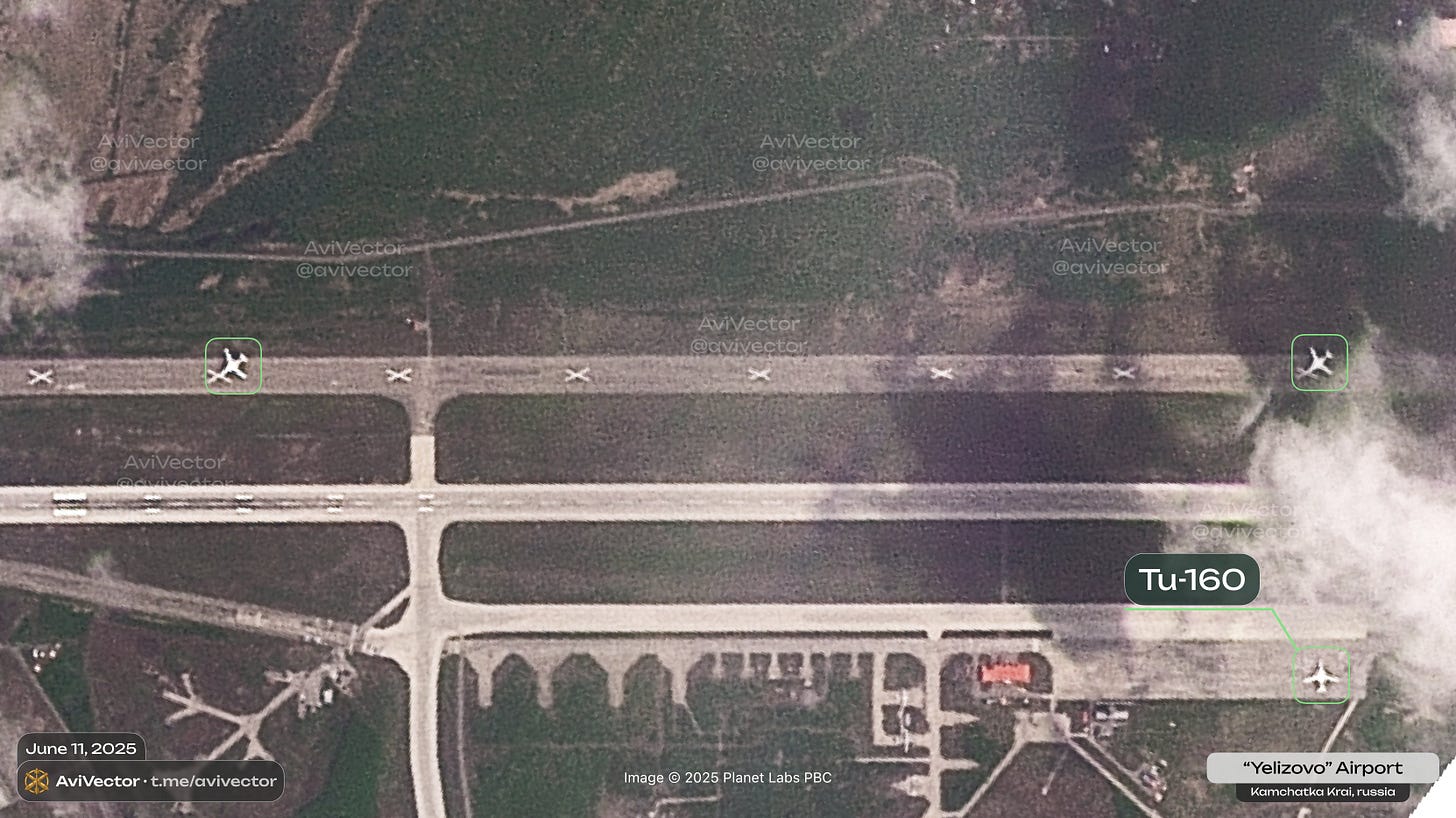Russia's Surviving Bombers Are Evacuating—Away From Ukraine's Deadly Drones
The most valuable Tu-160 bombers are heading to the Far East, thousands of miles from Ukraine
A great migration is taking place across Russia as the Russian air force’s surviving strategic bombers flee—largely to the east, away from Ukraine and the growing threat from Ukrainian drones.
The bomber evacuation comes a little more than a week since 100 short-range quadcopter drones, smuggled close to a quintet of Russian air bases by Ukraine’s state security service (SBU), destroyed 14 bombers, transports and radar planes at four of the targeted bases.
The 11 wrecked bombers—seven propeller-driven Tupolev Tu-95s and four jet-propelled Tupolev Tu-22Ms—represent around 14% of the active Russian bomber fleet. Neither type is in production; realistically, there’s no way for Moscow to directly replace the losses.
The surviving bombers are precious. Which is why the Russian air force is moving many of them as far from Ukraine as possible.
According to AviVector, a research group that scrutinizes satellite imagery to track Russian warplane deployments, all eight Tupolev Tu-160 bombers that were stationed at Belaya and Olenya air bases, respectively 2,700 and 1,200 miles from Ukraine and both targets of the June 1 raid, had vacated their bases by early June—and repositioned at a pair of airfields in Russia’s Far East plus one base outside Moscow.
Two of those bombers redeployed to Anadyr air base (4,200 miles from Ukraine), three went to Yelizovo air base (4,500 miles from Ukraine) and three to Borisoglebskoye air base (630 miles from Ukraine). Well within range of Ukraine’s deep-strike drones, Borisoglebskoye may be a temporary stop for the Tu-160s.
The remaining T-22Ms and Tu-95s are also scattering away from the bases the SBU struck on June 1: not just Belaya and Olenya, but also Dyagilevo, Ivanovo and Ukrainka. The latter three are respectively 410, 370 and 3,700 miles from Ukraine.
Perhaps most notably, four Tu-22Ms joined Antonov An-12 and An-26 transports at Mozdok air base in North Ossetia, which “had largely ceased to be actively used by Russian aviation,” according to AviVector.
Wherever the surviving 60 or 70 active bombers ultimately settle in, expect reforms meant to prevent a repeat of June 1.
Poor protection
“Russian force protection at their bases was atrocious” when the SBU’s quadcopters attacked, noted Ben Hodges, a retired U.S. Army general. Some Tu-22Ms sat in revetments, but other bombers—including Tu-95s—were parked in the open on their bases’ tarmacs.
The June 1 operation “struck the top of the food chain, so to speak, and will no doubt push Russians to adapt ad hoc defensive measure,” explained Samuel Bendett, an analyst with CNA in Virginia. The measures could include anti-drone nets and more hardened shelters.
But the main defense is simply basing the bombers farther from Ukraine. The extra distance complicates special operations. If the Ukrainians attack with long-range attack drones or missiles, the munitions will have to cover a lot of ground—exposing them to more Russian air-defenses.
“Some of the long-range drones and missiles will be shot down as they fly over Russia, so the longer the distance, the less effective the strike will be,” said David Kirichenko, an analyst who has written for the Center for European Policy Analysis in Washington, D.C.
But the distance cuts both ways. More of Russia’s bombers must travel thousands of miles, rather than hundreds, before they can fire their cruise missiles at Ukrainian cities. The extenuated flights take longer, cost more in fuel and maintenance and incur a long-term material cost as valuable airframes accumulate more wear and tear.
The real damage inflicted by Ukraine’s deep strikes isn’t necessarily the immediate tally of targets destroyed. “The attacks’ true impact lies in their ability to impose systemic stress,” explained Olena Lapenko, the general manager on security and resilience at the DiXi Group think tank in Kyiv.
The stress on the Russian bomber fleet is intensifying. It might take time for that stress to register in Ukraine, in the form of fewer missiles strikes on Ukrainian cities. But relief is coming as Ukraine’s drones attack—and Russia’s dwindling bomber force evacuates.
Read more:
Confirmed—Ukraine's Drones Blew Up At Least 1/7th of Russia's Flyable Bombers and Radar Planes
The Ukrainian state security agency, the SBU, initially claimed it struck 41 Russian warplanes during the agency’s Sunday special drone operation targeting five Russian air bases.








Thanks for the article David! Quick note, looks like you typo'd the number of bombers lost - you say 4 of each but I believe it was 7 Tu-95s, 4 Tu-22s.